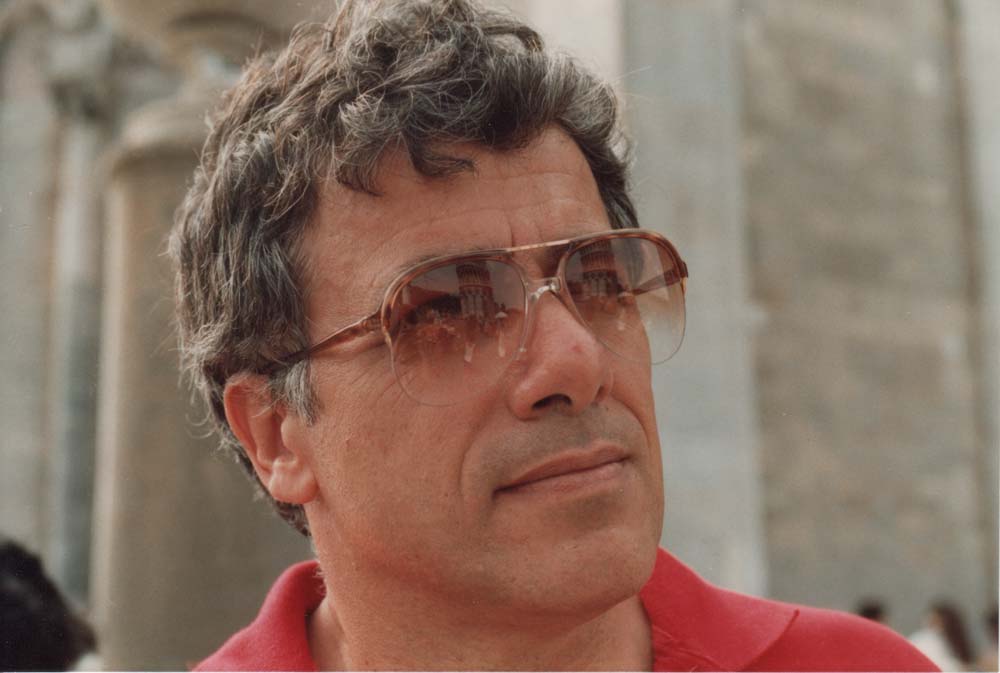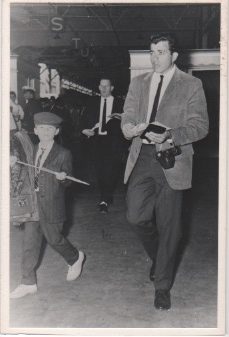About Richard Upton
Combining Art & Education Since 1965
Richard Upton, professor emeritus of art, died October 18, 2013, in Sarasota, Florida, of complications of Parkinson’s disease. He was 82.
Born May 27, 1931, in Hartford, Connecticut, Richard was a U.S. Navy veteran who served during the Korean War. He received formal training in painting and printmaking at the College of San Mateo in California; at the University of Connecticut, where he earned a B.F.A. degree; and at Indiana University, where he earned an M.F.A. He was a Fulbright Scholar in Paris, where he studied at the École des Beaux Arts and the Académie de la Grande Chaumiere, and also studied at the Provincetown Workshop.


About Richard
Richard joined the Skidmore faculty as an assistant professor of art in 1966 and retired in 1995 as a full professor, having taught painting and printmaking. Regis Brodie, professor emeritus of art, recalled that Richard’s influence was instrumental to the continuance of Summer Six. “The program was very young and there was discussion about discontinuing it,” explained Brodie. “Richard was a persuasive advocate of the program, first as a director and later as a supporter,” added Brodie, who directed Summer Six for 35 years.
A Dedicated Teacher
David Miller, professor emeritus of art, called Richard “a dedicated teacher” whose love of living and working in Cortona, Italy, was well known.
Richard’s paintings are included in such prestigious private and public collections as the Metropolitan Museum of Art and the Museum of Modern Art in New York City; the Art Institute of Chicago; the Smithsonian in Washington, D.C.; the Library of Congress; Bibliothèque Nationale, Paris; and the Victoria and Albert Museum in London.
STATEMENT OF PLANS
“For the past decade I have been painting en plein air in the hills of Tuscany primarily in and around the hilltown of Cortona. The artistic progression of these paintings is the consequence of a strong affinity for the region, its culture and its art. They reflect the dialectical relationship I find between the genre and notions about how art is made.
I seek to empower the landscape with heavily conditioned constructs and sets of inversions, of relationships like those between size and scale, window and wall or distinctions between sets of polarities such as harmony/discord and order/chaos that exists in nature. The conjoining of perception with imagination releases the translation of landscape into art. It allows, for example, a mark to both describe (nature) and respect its own identity and expression or, that nothing be independent from anything else. The evolution of these paintings done over the past decade and their progression of artistic vision, is tied to a continuity of experience in painting. A fellowship would play a crucial role at this time in the evolution and direction the new paintings are taking. The work produced would become the core of a museum exhibition currently under discussion.” – Richard Upton


As Featured
SELECTED EXHIIBITIONS: 1989-1998
1998
“The Drawings of Richard Upton: Ireland & Italy”
Ben Shahn Galleries, William Patterson University,
Wayne, New Jersey
1997
“Richard Upton Drawings-Paintings: Ireland & Italy”
List Gallery, Swarthmore College, Swarthmore, Pennsylvania
“The Language of Landscape: Paintings & Drawings
from the Collection of the National Academy of Design”
National Academy of Design, New York City
“The Tuscan Landscapes of Richard Upton”
Sordoni Art Gallery, Wilkes University,
Wilkes-Barre, Pennsylvania
The Drawings of Richard Upton: Ireland & Italy
1996
“Collections Update: Recent Acquisitions
National Academy of Design, New York City
1995
“Richard Upton: New Paintings:
Condeso/Lawler Gallery, New York City
1994
“The Artist in Rural Ireland: Images of North Mayo”
Philadelphia Art Alliance, Philadelphia, Pennsylvania
1993-1994 Forthcoming
“Richard Upton: Ten Years of Italian Landscapes Paintings, Drawings, Monotypes”
James A. Michener Art Museum
1992 10 April to 31 May
“The Italian Landscapes: Richard Upton at Cortona”
New Britain Museum of American Art
1991 25 October to 22 December
“Richard Upton: Italian Landscapes”
Krannert Art Museum & Kinkead Pavilion
1991 10 May to 16 June
“Tuscany Rediscovered: The Chronicles of Richard Upton”
Everson Museum of Art
1990 8 May to 30 June
“Paysage Demoralise: Landscape at the End of the Century”
Grey Art Gallery & Study Center/NYU
New York University, New York City
1989
“City on a Hill: Twenty Years of Artists at Cortona”
Georgia Museum of Art, Athens, Georgia

SELECTED BIBLIOGRAPHY 1989-1993
Robert Boyers. “The Attack on Value in 20th Century Art, History of European Ideas” Vol. 11, 1989, pp 490, 491.
Tom Sokolowski. “Paysage Demoralise: Landscape at the End of the Century.” Grey Art Gallery. 1990. New York University.
Michael Brenson. “Defining Nature by It’s Battle Scars.” New York Times, weekend section, 1990.
Kay Larson. “What on Earth.” New York Magazine, 1990.
Paul Hayes Tucker. “Richard Upton & The Rhetoric of Landscape.” 1991.
Sherry Chayat. “Umbria Rediscovered Richard Upton at Cortona.” Syracuse Herald American, feature weekend magazine section, June 1991.
Ann Harding. “Landscapes for Our Time: Upton Revives an Ancient Art.” Saratogian weekend feature, August 1991.
Sherry Chayat. “Intimate Vistas: The Landscapes of Richard Upton” forthcoming.
“The Italian Landscapes.” forthcoming, ART NEWS, 1992
William Zimmer. “Richard Upton at the New Britain Museum of American Art.” New York Times, Sunday Art section, May 1992.
“Art In America.” forthcoming 1993, article on the Italy paintings, drawings, and monoprints.